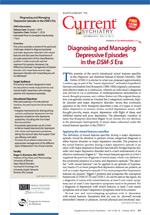Article Type
Changed
Mon, 04/16/2018 - 14:36
Display Headline
Diagnosing and Managing Depressive Episodes in the DSM-5 Era
Sponsor
This activity is jointly provided by RMEI, LLC and Postgraduate Institute for M…
Article PDF
Issue
Current Psychiatry - 14(10)
Publications
Sections
Article PDF
Article PDF
Sponsor
This activity is jointly provided by RMEI, LLC and Postgraduate Institute for M…
Sponsor
This activity is jointly provided by RMEI, LLC and Postgraduate Institute for M…
Issue
Current Psychiatry - 14(10)
Issue
Current Psychiatry - 14(10)
Publications
Publications
Article Type
Display Headline
Diagnosing and Managing Depressive Episodes in the DSM-5 Era
Display Headline
Diagnosing and Managing Depressive Episodes in the DSM-5 Era
Sections
Disallow All Ads
Article PDF Media
Document

